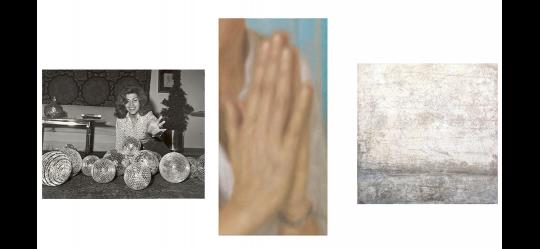Left: Monir Farmanfarmaian, in her salon, 1975, Tehran, Bukhara (Turkoman textile) in background_Courtesy of the artist and The Third Line, Dubai, Centre: Y.Z. KAMI Untitled (Hands) I, 2012 Oil on linen, 30 x 16 inches, (76.2 x 40.6cm) KAMI 2012.0010, © Y.Z. Kami. Photography by Rob McKeever. Courtesy Gagosian. Right: Taha Afshar, Untitled (Letting light in 13). 65 x 65 cm. Oil on Linen
Introduced by Mariam Neza, Programme Manager and Curator of Arts and Learning, Asia House
Panellists: Dr Ladan Akbarnia, Curator, Islamic Collections, British Museum Dr Sussan Babaie, Andrew W. Mellon Reader in the Arts of Iran and Islam, The Courtauld Institute of Art Dr Leonard Lewisohn, Senior Lecturer, Iran Heritage Foundation Fellow in Sufi Literature, Exeter University and Dr Taha Afshar, exhibiting artist.
The Garden of Mystery exhibition opens at Asia House on Tuesday 21 November in celebration of the 700th anniversary of Gulshan-i Raz, one of the greatest works of Persian (Sufi) poetry, written in the early 14th century by Mahmoud Shabistari. The group of paintings relate to the tenets and ideas referred to throughout the poem.Taha Afshar, Monir Farmanfarmaian and Y.Z Kami through their works of art invite us to contemplate spiritual ideas of unity, love, and our relationship with our heart, as Shabistari has done through his seminal work.
Gulshan-i Raz (Persian: ???? ?????, “Rose Garden of Mystery”) holds a unique position in Persian Sufi literature. Written in c. 1317 by Mahmoud Shabistari (d. c. 1339), less than one hundred years after the deaths of Attar, Ibn ali-‘Arabi and Rumi, it take the form of answers and questions put to him by a fellow mystic. The questions raise metaphysical enigmas and controversies that were at the heart of spiritual enquiry of that time and still have relevance today.
It is now considered to be one of the greatest classical Persian works of the Islamic mystical or spiritual tradition known since the early 9th century in the West as Sufism. From the opening verse, the poet delves straight into recurring themes of the poetry: the heart, soul, contemplation and illumination.
In the name of Him who taught the soul to think,
And kindled the heart’s lamp with the light of soul.
The spiritual themes presented in his poetry mirror ideas explored by not only poets such as Maulana Rumi, Jami, and Mansur al Hallaj, and preachers, but also Persian and Western Renaissance artists architects and calligraphist. Different elements of Sufi tradition and culture also impacted on the Romantics, several Modernists and a selection of post-war and contemporary artists such as the mystical portraiture of Maïmouna Guerresi, and the paintings and sculptures of London based Shirazeh Houshiary whose work has consistently drawn on Sufism, for its form and content. Earlier Western artists, such as Malevich, Ad Reinhardt and Kandinsky have used rhythmical patterns as a means by which to induce metaphysical principles allied to the experience of spirituality and of transcendence. Kandinsky’s “Concerning the Spiritual in Art” is important in the sense of redefining painting’s role in exploring man’s inner spiritual struggle in his vision for modern art. In this context, Shabistari’s work provides another lens and framework to capture mankind’s journey and relationship with his heart and the cosmos and to traditionally decipher signs of the Divine.
Join us in exploring this fascinating work of literature and complementary exhibition where we will discuss and celebrate Mahmoud Shabistari’s poetry in depth by eminent experts on the subject of The Garden of Mystery, 700th anniversary and the influence of Sufism in contemporary visual arts.
Panel Discussion | ‘The Garden of Mystery’ by Shabistari and the Influence of Sufism in Contemporary Visual Arts
Asia House, 63 New Cavendish Street London

Ad
Event has ended
This event ended on Tuesday 28th of November 2017
This event ended on Tuesday 28th of November 2017
Admission
Free
Free
Website
Tags:
Art
User Reviews
There are no user reviews
